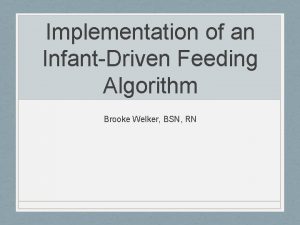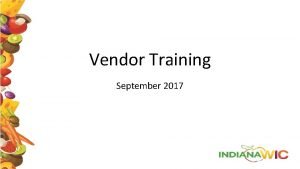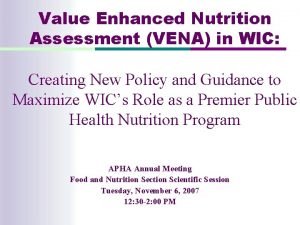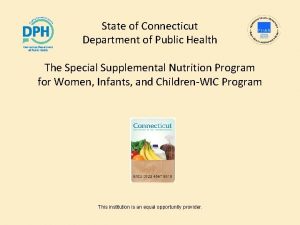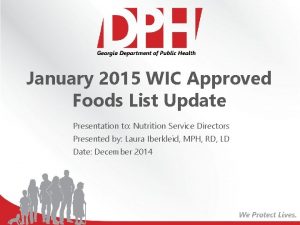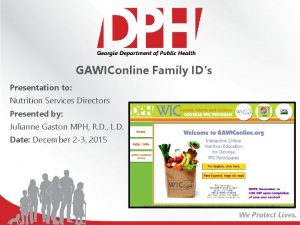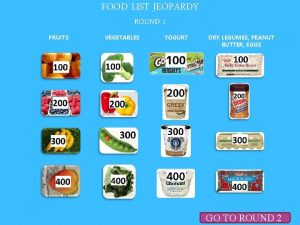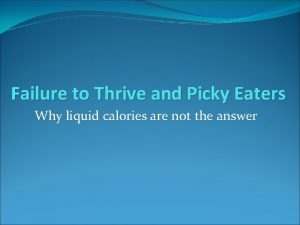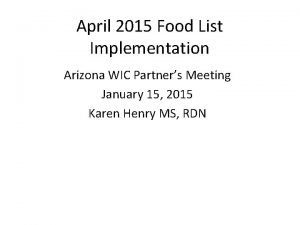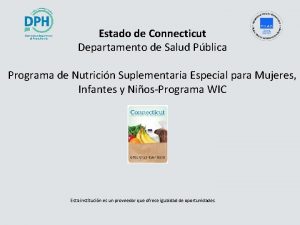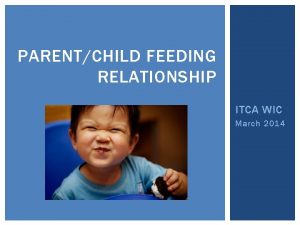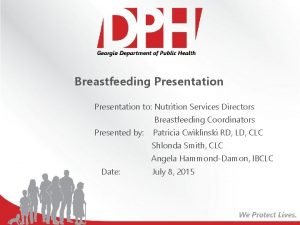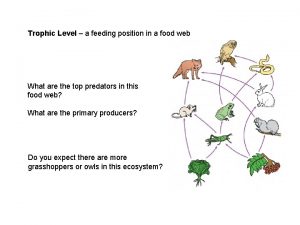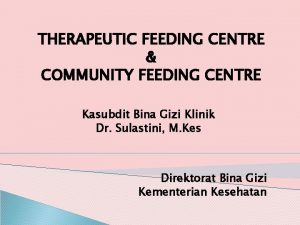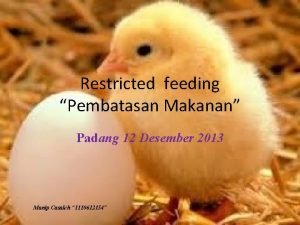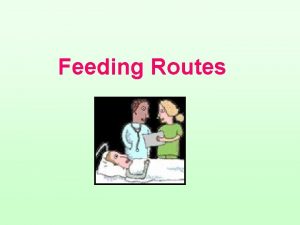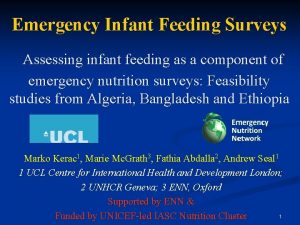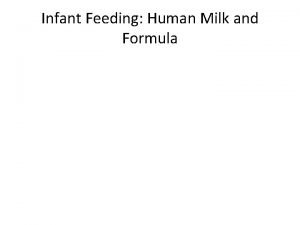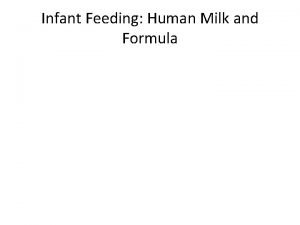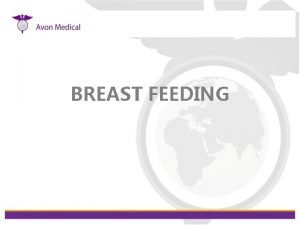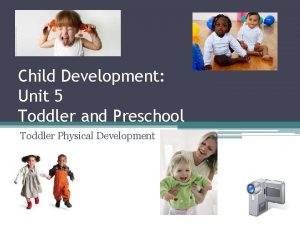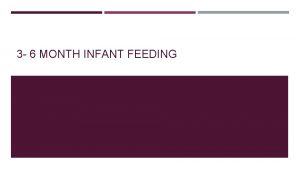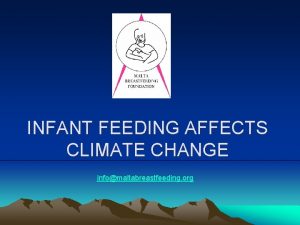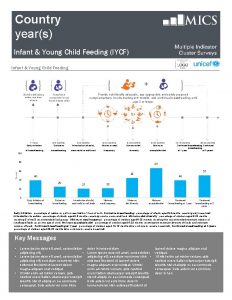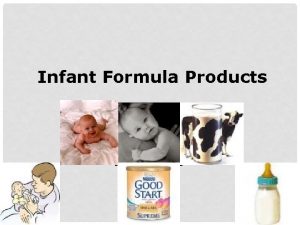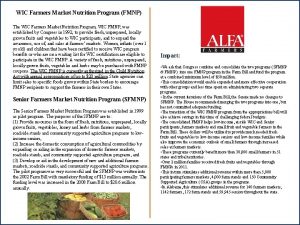WIC Infant Toddler Feeding Practices Study 2 Infant











































- Slides: 43

WIC Infant Toddler Feeding Practices Study – 2: Infant Year Report 2017 National WIC Association Annual Education and Training Conference & Exhibits Courtney Paolicelli, USDA FNS Nancy Weinfield, Westat Shannon Whaley, PHFE WIC 1

Purpose The Feeding My Baby Study (WIC ITFPS-2) addresses: • Infants’ and children’s feeding practices • Associations between WIC services and: – feeding practices – Health and nutrition outcomes of children receiving WIC. Infant Year Report Focus: • Breastfeeding initiation and duration, and • Introduction of complementary foods. Comparisons with the 1997 WIC Infant Feeding Practices Study– 1 (WIC IFPS-1). 2

Methodology • Longitudinal study • Follows infants enrolled in WIC from birth to age 5 • Nationally representative • Began Fall 2013 3

Study Participants Eligibility Requirements • Pregnant or infant less than 2. 5 months old • First time enrolling in WIC for this pregnancy or child • At least 16 years old • Speaks English or Spanish 3, 777 infants in sample for this report 4

Study States (27) and Sites (80) 5

Data Collection WIC Site Data • Site visits • Key Informant Interviews (State and Local Agency) • WIC staff survey WIC Participant Data • Enrollment on site • Follow-up telephone interviews • WIC Administrative Data • Height/weight data for those off WIC 6

Data Collection 7

Infant Data Collection • Interviews conducted every 2 months • Incentive for completing telephone interview • N=3, 777 caregivers (completed at least a 1 or 3 month interview) Birth 1 3 5 7 9 11 13 8

9

Study Sample 10

Demographic Characteristics Racial and Ethnic Distributions Other 15% White 59% African American or Black 26% Hispanic/ Latino 38% Non. Hispanic 62% 11

Demographic Characteristics Parity Mother’s Age Third or Subsequent born 16 -19 years 26+ years 12% First born 32% 47% 41% 27% 20 -25 years Second born 12

Breastfeeding Beliefs and Intentions 13

Prenatal Views: Benefits of Breastfeeding Maternal Attitudes and Beliefs Benefits of Breastfeeding Breastfed babies are healthier than formula-fed babies. Breastfeeding helps protect the baby from diseases. Percentage of Mothers Agreeing with Statement WIC IFPS-1 WIC ITFPS-2 (1994 -95) (2013 -14) Direction of Change 61 77 79. 7 81. 2 ↑ ↑ Breastfeeding is easier than formula feeding. 50 55. 3 ↑ Breastfeeding brings a mother closer to her baby. 81 87. 9 ↑ Breastmilk alone gives a new baby all he/she needs to eat. Breastfeeding reduces the risk of a child becoming overweight. Breastfeeding helps women lose weight. 71 71. 3 ↑ Not Asked 50. 0 -- 53 74. 5 ↑ 14

Prenatal Views: Barriers to Breastfeeding Maternal Attitudes and Beliefs Barriers to Breastfeeding ties you down. Percentage of Mothers Agreeing with Statement WIC IFPS-1 WIC ITFPS-2 (1994 -95) (2013 -14) Direction of Change 41 17. 3 ↓ Breastfeeding takes too much time. 34 14. 7 ↓ Breastmilk leaking onto your clothes is something that I worry about. Breastfeeding in public is not something that I want to do. Breastfeeding is painful. 46 27. 4 ↓ 61 36. 9 ↓ 39 43. 6 ↑ Breastfeeding means no one else can feed your baby. 48 50. 8 ↑ With bottle feeding, the mother knows that the baby is getting enough to eat. 76 67. 0 ↓ 15

Infant Feeding Intention (IFI) Scale Scores • 0 -16 point scale composed from five questions • Higher scores = stronger intention to breastfeed Nearly ¾ of prenatal WIC participants have a moderate to very strong intention to exclusively breastfeed. 39% 22% 6% 4% IFI Scale score range Very Low (0 -3. 5) Moderate (8 -11. 5) Very Strong (16) Low (4 -7. 5) Strong (12 -15. 5) 16

Breastfeeding Behaviors 17

Breastfeeding Rates Increased Since 1994 83% Breastfeeding Rates by Month 61% 56% WIC ITFPS-2 WIC IFPS-1 42% 33% 26% 22% 18% 21% Initiation Month 1 Month 3 16% 12% 10% Month 5 Month 7 Month 9 Month 12 NOTE: Similar slopes in trend lines between studies. 7% 18

Breastfeeding Initiation by Race and Ethnicity 91% 84% 74% 53% 62% 92% 84% 34% African American or Black White ITFPS-2 76% Other NA IFPS-1 Hispanic/Latino ITFPS-2 Non-Hispanic IFPS-1 19

Expressing Breastmilk Percentage of Breastfeeding Mothers Who Report Expressing Breastmilk During the Past Week 59% 56% 47% 42% 36% 24% NA Month 1 Month 3 ITFPS-2 Month 5 NA Month 7 IFPS-1 20

Rates of Exclusive Breastfeeding and Combination Feeding Healthy People 2020 Goals: 46% exclusively breastfeeding through 3 months; 26% exclusively feeding through 6 months 31% 22% 30% Month 1 16% 12% 20% 16% 15% Month 3 Month 5 Month 7 Exclusively BF Combination Feeding (BF + FF) 21

Top Reasons for Breastfeeding Cessation At 3 months, top reasons why mothers stopped breastfeeding: 1. Breastmilk alone did not satisfy baby (57%) 2. I didn’t produce enough breastmilk (56%) 3. Baby lost interest in nursing (34%) 22

Moms Not Breastfeeding As Long As They Intended Percentage of Breastfeeding Mothers Who Met Their Personal Breastfeeding Goals, by Length of Goal 72% 69% Met goal 28% 31% Did not meet goal 6 months or less More than 6 months Length of breastfeeding goal 23

Introduction of Complementary Foods 24

Early Introduction of Complementary Foods is Less Prevalent WIC IFPS-1 (1994 -95) WIC ITFPS-2 (2013 -14) 38% 62% 20% 80% Introduced complementary foods before 4 months No introduction of complementary foods before 4 months 25

Complementary Foods Are Being Introduced Later Mean Age (in Months) Infants Were Introduced to Complementary Foods 8 6 6 5 3. 5 Infant Cereals 4 Fruits WIC ITFPS-2 (2013 -2014) Vegetables Meats WIC IFPS-1 (1994 -95) 26

Caregivers’ Perceptions of WIC 27

WIC Positively Impacts Breastfeeding Behaviors • For > 95% of breastfeeding mothers, WIC played an important role in breastfeeding decision • 61% identified the enhanced food package as an important factor in their breastfeeding decision – Moms aware of the enhanced food package breastfed for 1. 5 months longer 28

WIC is a Trusted Source of Information on Infant Feeding Percentage of Caregivers that Received Feeding Information by Source Doctor or health professional 66% 59% WIC office or clinic 56% Family member Internet or parenting websites 34% Husband/boyfriend 32% 25% Books or magazines 23% A friend Mom's group or class 9% 29

Additional Support Provided by WIC • Postpartum women who received support calls from WIC were more likely to be breastfeeding exclusively at 1 month 30

Perceived Influence of WIC on Feeding • About 60% of study mothers indicate they made positive changes in feeding practices because of something they learned at WIC. • Most common changes at 13 months were: – Know how to choose more healthy foods for myself/family (34%) – Eat more fruits and vegetables (27%) 31

Key Findings • Breastfeeding rates have risen dramatically over the past 20 years. • Early introduction of complementary foods is less prevalent among WIC participants than previously. • Caregivers credited WIC with making positive changes in how they feed their infants and themselves. • Participants reported extensive support from WIC. 32

Future Directions 33

Next Steps • Analyzing toddler data through 24 months • Currently collecting 36 & 42 month data (48 month data collection starts in late April!) 34

How You Can Stay Involved • Download the full report 35

How You Can Stay Involved 36

How You Can Stay Involved 37

How You Can Stay Involved 38

How You Can Stay Involved • Download the full report • Share the infographic 39

How You Can Stay Involved 40

How You Can Stay Involved • Download the full report • Check out the infographic • Support the study team with final rounds of data collection 41

Height/Weight Card 42

Thank you! Courtney. Paolicelli@fns. usda. gov 703. 605. 4370 43
 Drdp infant toddler essential view
Drdp infant toddler essential view Infant/toddler sensory profile score sheet
Infant/toddler sensory profile score sheet Interpreting brigance scores
Interpreting brigance scores Abbott feeding pump error codes
Abbott feeding pump error codes Infant-driven feeding scale
Infant-driven feeding scale Banajee list of toddler vocabulary
Banajee list of toddler vocabulary Antibiotics for uti in toddler
Antibiotics for uti in toddler Toddler dönemi nedir
Toddler dönemi nedir Toddler fracture
Toddler fracture Baby temperature chart
Baby temperature chart Malaguzzi quotes
Malaguzzi quotes History of wic
History of wic Wic approved juice
Wic approved juice Vena wic
Vena wic Wic approved formula ga
Wic approved formula ga Wic approved cereal
Wic approved cereal Pars state wic
Pars state wic Oregon wic program
Oregon wic program Nbulgur
Nbulgur Wic cereal list
Wic cereal list Georgia wic
Georgia wic Gwis wic
Gwis wic Wic oatmeal
Wic oatmeal Wic yogurt
Wic yogurt Wic in cold chain
Wic in cold chain Arizona wic food list
Arizona wic food list Wic approved whole milk yogurt
Wic approved whole milk yogurt Tn wic food list
Tn wic food list Wic similac total comfort
Wic similac total comfort Wic certification
Wic certification Integrated eligibility system (ies)
Integrated eligibility system (ies) Formulas aprobadas por wic
Formulas aprobadas por wic Itca wic
Itca wic Wic pcdb
Wic pcdb Wic handelsroute
Wic handelsroute Nc wic formula
Nc wic formula Georgia wic formula
Georgia wic formula Itca wic
Itca wic Wic pcdb
Wic pcdb Feeding position in a food chain
Feeding position in a food chain Penyakit masyarakat sasaran bintibluh
Penyakit masyarakat sasaran bintibluh Restricted feeding
Restricted feeding Tilapia feeding guide philippines
Tilapia feeding guide philippines Night of the scorpion nissim ezekiel
Night of the scorpion nissim ezekiel




